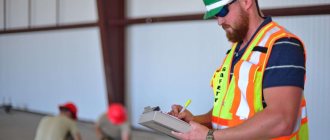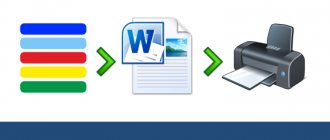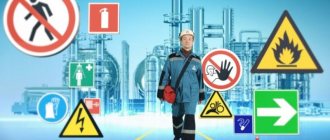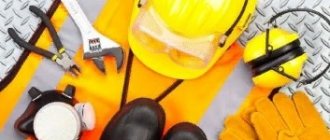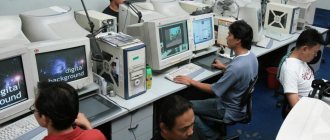Carrying out technical work on the maintenance and repair of automotive equipment is regulated by its own labor protection rules. While performing his duties, a mechanic can use not only improvised tools, but also complex technical products and power tools. Plus, some types of work must be performed with a certain order of actions to preserve the life and health of the employee. Therefore, according to TB, separate instructions on labor protection are provided for mechanics.
Working conditions and tasks of an auto mechanic at an enterprise
In order to understand what danger a car mechanic faces when working with various mechanical tools and electrical appliances, it is necessary to have an idea of the functions he performs, which are specified directly in his job description. Occupational safety for mechanics involved in the repair, equipment and maintenance of vehicles involves compliance with all safety rules and all operating standards for devices, which makes it possible to minimize the causes of accidents. What are the responsibilities of a vehicle mechanic?
- Chassis: maintenance and repair work.
- Internal combustion engines (ICE): repair, washing.
- Injection engine injectors: cleaning, maintenance.
- Gearbox: repair work.
- Fuel equipment: gas tank repair.
- Anti-lock brake system (ABS) repair.
- Setting and fitting the airbag (SRS).
- Service of the wheel slip control system (EDS).
- Supports multi-mode transmission (SUPER SELECT).
- Maintenance of units and components.
- Installation work, wheel alignment adjustment.
- Balancing and tire fitting work.
- Crankcase protection installation services.
- Carrying out maintenance.
- Recording completed work in a worksheet and much more.
Any car garage that provides relevant services requires the presence of several specialists of this category on site. Moreover, each enterprise that has a certain number of vehicles on its balance sheet also employs employees of this category in the person of one or more mechanics and a chief mechanic. The labor safety instructions for each specialist in the installation and technical department require employees to study each of its sections. The sections provide information about general provisions, rules for preparing the workplace, the mandatory nature of certain actions at the time of direct installation and repair work, and standards of conduct at the time the work is completed. Among other things, a separate section contains information about the rules of behavior in emergency situations.
Features of TB for electromechanics
The job description of a signaling electrician obliges the employee not only to troubleshoot problems in a timely manner, but also to promptly repair failed components without significant damage to the train schedule. There is often a rush to such unforeseen breakdowns, which is why many railway workers have died under the wheels of the train. Therefore, it is important for an electromechanic, first of all, to observe safety precautions when working on the railway, and, of course, not to forget about the rules for qualifying work with electric current.
An example of a safety violation by a signaling electrician: you cannot work with your back to the railway track
General provisions
The initial danger may come from work equipment and special technical equipment. A standard labor safety instruction for a motor vehicle mechanic begins with general provisions. They include a list of those points, familiarization with which is mandatory for every specialist who holds this position at the enterprise.
- Hiring a master for technical installation of motor vehicles requires the applicant to reach the age of eighteen. At the same time, he must undergo a medical examination, where the conclusion will indicate the absence of any contraindications for health reasons.
- Occupying a mechanic position implies having a third or higher clearance group in terms of electrical safety. The specialist must undergo introductory and initial training at the workplace, and also be familiar with safe work practices.
- The future employee undergoes an internship at a specific workplace with mandatory theoretical knowledge. This is a kind of check of a new staff unit by the management of a motor transport enterprise. In addition, an employee of the auto mechanics department must undergo regular instruction on labor protection at least once every six months, and at least once a year he must undergo a medical examination at the clinic - these decisions are provided for by order of the Ministry of Health and Social Development No. 302N, approved on April 12, 2011.
- In addition to scheduled briefings, the mechanic is required to undergo unscheduled briefings, which may be due to changes in technological processes, adjustments to labor protection rules, replacement or improvement of one of the vehicles, its parts and specific devices, as well as changes in working conditions in the workplace.
- In his direct work activities, an auto mechanic must be guided by the internal staff regulations and comply with the requirements of the labor protection instructions, as well as the provisions on fire and electrical safety measures.
- Personal protective equipment and items of workwear issued to a full-time employee must be used exclusively for their intended purpose. In addition, the issued inventory and work equipment require careful handling and proper tidying up as necessary (cleaning, washing).
- After carrying out work, a mandatory factor is the observance of precautions in terms of personal hygiene: the remains of products used by the mechanic during the work process must be thoroughly washed off with soap, especially before eating, which is of fundamental importance.
- An employee of the auto mechanics department must be aware of the location of the first aid kit and fire extinguishing equipment and be able to use them in the event of an emergency. In addition, he, like any other employee of the enterprise, must be familiar with the basic concepts of first aid.
Among other things, according to the standard labor protection instructions for a motor vehicle mechanic, as, in principle, in any other field of activity related to repair and maintenance, it is not permissible to leave your workplace without the permission of the chief mechanic. An ordinary employee should also not perform work that is not assigned to him by management. It is prohibited to smoke or eat food at the workplace during working hours - this is done exclusively in designated areas: smoking is allowed in the smoking room, and dining is allowed in the dining room or a special room for eating.
IV. Rights
The chief engineer has the right:
4.1. Represent the interests of the technical services of the enterprise in relations with other structural divisions of the enterprise, other organizations and government bodies.
4.2. Submit proposals for improving the activities of the enterprise (department) for consideration by management.
4.3. Sign and endorse documents within the scope of competence, issue orders for the enterprise with your signature on issues of production activities.
4.4. Interact with the heads of all services on issues within his competence.
4.5. Receive from the heads of structural divisions of the enterprise and specialists the information and documents necessary to fulfill their official duties.
4.6. Inspect the activities of the structural divisions of the enterprise in the field of technical preparation of production.
4.7. Take part in the preparation of orders, instructions, instructions, estimates, contracts and other documents related to the production activities of the enterprise.
4.8. Require the management of the enterprise to provide assistance in the performance of their official duties and rights.
4.9. [Enter as appropriate].
Factors that pose a threat
In fact, there are a number of different points that a transport technician should be careful of when performing his immediate duties. Their list is also specified in the basic labor protection instructions for a garage mechanic. The following aspects pose danger:
- moving mechanisms and machines, as well as moving parts of working equipment;
- excessively high or low temperature of the equipment itself and materials with which the mechanic has to work (carburetor, injector, engine parts);
- high mains voltage, which can result in a short circuit;
- increased static electricity;
- sharp edges, gaps and roughness in workpieces, tools and equipment that the mechanic directly uses in the work process;
- dislocation of the mechanic's workplace at relatively high surface levels from the floor or, conversely, underground - in a caisson (garage pit);
- increased dust and gas contamination of the working space (car exhaust gases, sediment from the use of working tools, etc.);
- lack of sound insulation - excessive vibration and noise of operating engines, equipment, tools negatively affect concentration in the work process;
- serious deviations from the norm in the level of air humidity in the garage;
- abnormal changes in air temperature at the mechanic’s workplace;
- poor lighting in the work area of the master technician in the garage;
- sliding surfaces of the floor, tables, machines at which the garage employee works.
In order to avoid damage and work-related injuries, mechanics must be provided with special clothing, as well as special footwear and other necessary means that provide personal protection and are provided for by the current labor safety standards at an enterprise of this type of activity. The use of protective equipment whose expiration date has already expired is not allowed.
In order to avoid loss of attentiveness and orientation at the workplace during the work process, the use of alcohol and drugs, as well as being in a state of intoxication (alcohol or drugs) at work is also strictly prohibited. If any unforeseen situation threatens the life and health of employees in this sector of the work process, the mechanic must necessarily report what is happening to immediate management. If an ordinary or chief mechanic fails to comply with instructions on labor safety and the release of vehicles for scheduled purposes, the garage employee may be held accountable in accordance with the current legislation of the Russian Federation.
OCCUPATIONAL SAFETY REQUIREMENTS DURING WORK
3.1. During work, use only serviceable tools, lifting equipment, devices (safety, portable and mobile, for work at height), personal protective equipment. 3.2. It is prohibited to remove fences, locking and other devices that ensure labor safety from technological equipment in operation. 3.3. It is prohibited to touch moving mechanisms and rotating parts of machines, as well as live parts of equipment. 3.4. It is necessary to keep the work area clean and tidy. 3.5. When starting up the machine, you should personally make sure that there are no workers in the machine operating area. 3.6. All repair work on electrical installations, preventive inspection, and repairs should be carried out with the fuses (voltage) removed. Check the absence of voltage on live parts of electrical equipment with a voltmeter or voltage indicator. 3.7. Immediately after the necessary shutdowns are carried out, posters should be posted on the switching equipment (machine, switch, circuit breaker) that were turned off during preparation of the workplace: “Do not turn on - people are working!” 3.8. For work, use hand tools with insulating handles (pliers, pliers, wire cutters, screwdrivers); the dielectric coating must not be damaged and fit tightly to the handle. 3.9. Elimination of damage and repairs to equipment must be carried out with complete removal of tension from the equipment. 3.10. The portable power tool used (soldering iron, step-down transformer, etc.) must be tested and have an inventory number, and be systematically and promptly checked and repaired. 3.11. When performing work at a workbench: - prepare the necessary tools; — check its serviceability, place it in an order convenient for work; — securely fasten the workpiece in a vice or on a workbench; — chopping metal with a chisel should be done while wearing mesh glasses; - when cutting metal with hand-held and powered hacksaws, tighten the hacksaw blades and secure them firmly; — when working with a hacksaw, you must first file the cutting area with the edge of a triangular file; — metal shavings should only be removed with a brush; It is forbidden to blow away shavings with your mouth or remove them with your hands; - clean files from shavings with a special metal brush; Do not knock out chips with blows of the file. 3.12. When working on drilling and sharpening machines, it is necessary to comply with the requirements of labor protection instructions and requirements, inter-industry rules for labor protection during cold metal processing and current labor protection instructions adopted by the organization. 3.13. When working with power tools: — ground the body of the power tool; — put on dielectric gloves and place a dielectric rubber mat under your feet; — protect the wire from mechanical damage, do not leave it in passages and passages; — disconnect the power tool from the network when it overheats, when moving to another place of work, or when there is a power outage. 3.14. Unpressing and pressing of pulleys, coupling halves, and bearings should be done using special pullers. It is forbidden to knock down parts with a hammer or use steel attachments. If it is impossible to use pullers or a press, use drifts with copper tips and hammers with copper strikers. 3.15. Monitor the fastening of safety covers in devices that ensure the impossibility of sudden action of springs when assembling and disassembling mechanisms and components. 3.16. Monitor the serviceability and reliability of fastening of the hydraulic system hoses when working on disassembly and assembly stands and other stands with a hydraulic device. 3.17. When working with a blowtorch: - check the serviceability of the lamp, make sure there are no fuel leaks or tightness of the plug; — use flammable liquid intended for this lamp (do not use leaded gasoline as fuel); - pour fuel into the lamp, after cooling it; - pump air into the lamp with a pressure no more than permissible; — fill the lamp cylinder with fuel to no more than ¾ of its capacity; - screw the lamp cap all the way; — if a malfunction is detected (fuel leak, gas passing through the burner thread, etc.), immediately extinguish the lamp and replace it with a working one. 3.18. Before a test run of repaired equipment, you must: — install and secure all fences, locks and other protective equipment; — remove strangers if they are nearby; — make sure that there are no foreign objects or parts on the repaired equipment; — before turning on, sound a beep. 3.19. The mechanic is prohibited from: - using faulty tools, devices, mechanisms that do not correspond to the work being performed; - use the tool for purposes other than its intended purpose; — lengthen the wrenches by attaching another wrench or pipe; - hit the key with a hammer; — place metal plates between the nut (bolt head) and the wrench; - unscrew nuts and bolts using a chisel and hammer; — work with faulty lifting mechanisms and load-handling devices; - lay out and leave tools, parts, fastening materials and other objects loose on ladders and stepladders to prevent them from falling; - carry the tool in the pockets of overalls; to carry the tool you must use special boxes; - work with power tools from portable ladders; — attach parts, fixtures or tools to operating equipment; — jump off ladders and stepladders; - carry loads manually in excess of the established norm. 3.20. If you feel unwell, stop working, turn off the equipment, notify management and consult a doctor.
Rules for preparing to start the work process
Before immediately starting to perform his job duties, a vehicle repair and maintenance specialist must follow certain occupational safety requirements. The instructions for mechanics provide for a number of preparatory procedures at the initial stage of performing functional duties.
- The first thing a garage technician must do is put on his work uniform and special shoes, as well as prepare all personal protective equipment (PPE) - gloves, goggles, a mask if necessary. It should be noted that at this moment the hair should be tucked under the headdress, and the pockets should be checked for the presence of foreign objects and items.
- At the beginning of the working day, the mechanic receives direct tasks to complete from his supervisor, if necessary. In addition, if necessary, he also receives information in the form of instructions on the safety of the upcoming work.
- At the beginning of the shift, before the immediate departure of vehicles to their destinations, the mechanic is required to conduct a visual inspection of all cars and trucks that are about to depart. For example, in logistics centers in the enterprise garage there are a lot of vehicles through which goods are transported to retail outlets from the warehouse. And, according to the instructions for occupational safety and equipment, the mechanic, in order to prevent and minimize the risks of an emergency, carefully and thoroughly inspects all the working systems of the car: checks the brake system, engine, safety system, strength of the wheels, etc.
- Directly at the workplace in the garage, a specialist must inspect the surface of the floors for slipping and clutter with unnecessary garage or other equipment. If it is necessary to increase lighting, the mechanic must take care of organizing additional lamps, spotlights, and light sources.
- Also, according to the labor safety instructions, the chief mechanic, like the private, has the task of monitoring the serviceability of existing equipment and working service platforms.
- Throughout the workday, the mechanic must ensure that equipment that is not currently in use is disconnected from the power supply. If necessary, he identifies areas for repair work by installing barriers and places appropriate posters along the perimeter of this segment with inscriptions like: “Attention! Work is underway, don’t turn it on!”
- During the work, the mechanic also checks the degree of wear of the equipment and its compliance with working conditions. If any equipment has exceeded its operating norm, the mechanic informs management about this, and then the issue of writing off such equipment is decided.
Mechanic's instructions for putting cars on production line
The mechanic’s instructions for releasing cars onto the line regulate the responsibilities for constant monitoring of the serviceability of the rolling stock, taxi fleet, etc. Before releasing the car onto the line, the mechanic checks the serviceability of all components. The operation of the vehicle is also monitored. If an unscrupulous driver treats the vehicle entrusted to him negligently, the mechanic is obliged to report this to his superiors. After checking the vehicle for suitability for the route, the mechanic draws up an order.
For your information! Depot and taxi mechanics are directly involved in undergoing technical inspection by government inspection bodies.
Order for a mechanic to produce vehicles, sample
Working with non-mechanized tools
The occupational safety instructions for mechanics at an enterprise provide for the specifics of operating both equipment connected to power and non-mechanized tools. As for the latter, the specifics of the work of a garage installation technologist require him to observe certain precautions. What does this include?
- Checking the appearance and strength of the assembly (tools with a wooden handle must be equipped with hard materials, smoothly processed surfaces without gouges, chips, or other defects).
- Inspection of tools for mounting on a console with a strong wedge in the free edge of the handle (chisels and bits should be equipped with mild steel tips, and handles should not have cracks, snags, or splits).
- Measuring the sizes of wrenches to the corresponding nuts and bolt heads.
- In the case of metal cutting, a mandatory check is carried out to ensure that the discs are securely fastened to the workbench, as well as the serviceability of the notch.
- The screwdriver handle is securely fastened so that the rod sits firmly in the handle with its side edges.
- Particular attention is paid to working with the jack: before using it, the mechanic must inspect the equipment for serviceability, determine the service life, taking into account the data from the technical passport, and evaluate the tightness of the pneumatic and hydraulic connections. In addition, the garage specialist must ensure that the jacks have locking devices that prevent the possibility of the screw coming out and the car spontaneously lowering when removed from the lever.
Working with electrified tools
In the case of using electrified tools in work, the mechanical engineer’s labor protection instructions also provide for some mandatory measures in the process of preparing electrical equipment for the work process. The mechanic’s actions in this case are aimed at checking:
- protection of all electrical appliances and power tools with insulated contacts of electrical wires: to prevent their interaction with moisture and the possibility of mechanical damage, the wires are protected with rubber hoses and secured at the free end with a plug with a special plug;
- location in a safe and convenient place for all equipment connected to electrical power;
- the presence and serviceability of the warning system of the equipment, as well as the grounding of the neutralizing wires (if necessary, the ventilation system must also be inspected);
- safety of the trajectory of moving equipment - all surfaces must be smooth, stable, non-slippery;
- the serviceability of portable ladders and stepladders when working with electrical appliances in the hands on a hill - it is necessary to examine the strength of the structure and the reliability of the fastenings, as well as the surface of the material for the presence of knots, cracks, protruding bolts that can injure; in addition, on the legs of the ladders there must be rubber or silicone “shoes” for support, which are designed to prevent slipping on the floor surface, and on the bowstring of the ladder the period of use must be indicated with an inventory number that determines whether it belongs to a specific enterprise.
The mechanic is prohibited from starting to perform his duties if a malfunction is detected in the technical equipment of devices, devices and tools, which are specified in the product manufacturer’s instructions. It is also prohibited to start work in the absence of personal protective materials. If a mechanic discovers any of the described problems in a garage with vehicles, he must report it to his immediate superiors.
OCCUPATIONAL SAFETY REQUIREMENTS BEFORE STARTING WORK
2.1. Wear proper special clothing, shoes, and prepare the necessary personal protective equipment (PPE). Check that there are no foreign objects in the pockets. The cuffs of sleeves and trousers must be buttoned, and hair must be tucked under the headdress. 2.2. Receive a task for the working day from your immediate supervisor, and, if necessary, receive targeted instruction on safety measures for the upcoming work. 2.3. Check by visual inspection: - sufficiency of lighting; — serviceability of the floor surface, which must be clean, non-slip, level and not cluttered with foreign objects; — serviceability of service areas; — disconnecting the voltage on live parts of equipment located near the work site; — availability of appropriate posters and safety signs; — serviceability of a portable electric lamp for local lighting with a voltage of 12-42 V. 2.4. Make sure that the equipment being repaired is disconnected from the power supply, freed from the product, cooled to a temperature not exceeding 30 degrees, the drains on the pipelines are open, the electric motors are turned off and measures are taken to prevent their accidental starting. 2.5. If it is necessary to separate the area under repair by installing a barrier, posters should be hung on the valves and valves of the shutdown equipment: “Do not turn on - people are working!” 2.6. Check that the tools and devices used in the work are in good condition, not worn out and meet safe working conditions. Non-powered tools 2.6.1. Wooden tool handles must be made of seasoned hard and tough wood, smoothly processed, and their surface must be free of gouges, chips and other defects. The tool must be properly seated and firmly secured. Impact tools (hammers, sledgehammers, etc.) must have oval handles with a thickened free end. The arm on which the tool is mounted must be wedged with a completed mild steel wedge. Metal (bandage) rings must be mounted on the wooden handles of pressing tools (files, chisels, etc.) at the points where they interface with the tool. 2.6.2. Impact instruments (chisels, crosscuts, bits) must not have cracks, burrs, or hardening; their occipital part should be smooth, free from cracks, burrs and bevels. The length of a hand chisel is at least 150 mm, their extended part is 60-70 mm; The sharpening angle of the blade is in accordance with the hardness of the materials being processed. 2.6.3. Forging tongs and other devices for holding the forgings being processed must be made of mild steel and match the dimensions of the forgings. To hold the forging without constant hand pressure, the pliers must have rings (spreads), and to protect against injury to the worker’s fingers, there must be a 45 mm gap (in working position) between the plier handles, for which stops must be made. 2.6.4. Wrenches must match the size of the nuts and bolt heads. The jaws of the keys must be parallel and free of cracks and nicks, and the handles must not have burrs. Sliding keys should not have any play in the moving parts. 2.6.5. The crowbars should be round in cross-section and have one end in the shape of a spatula and the other in the form of a tetrahedral pyramid. Scrap weight within 4-5 kg, length 1.3-1.5 m. 2.6.6. Pullers must have working claws, screws, rods and stops. 2.6.7. The vice must be securely fastened to the workbench. The jaws must have a proper notch. 2.6.8. The screwdriver must have a straight shaft and be firmly attached to the handle. The screwdriver must have smooth side edges. 2.6.9. Needle-nose pliers and pliers should not have chipped handles. The jaws of the needle-nose pliers are sharp, not chipped or broken, the pliers have a proper notch. 2.6.10. Hand scoops for collecting garbage should be made of roofing iron and should not have sharp ends or torn places. 2.6.11. Before using the jacks, check: - their serviceability, test periods according to the technical passport; — hydraulic and pneumatic jacks have tight connections. In addition, they must be equipped with devices that fix the rise, ensuring a slow and quiet lowering of the rod or stopping it; - screw and rack jacks must have a locking device that prevents the screw or rack from completely coming out; — manual rack and pinion jacks must have devices that prevent spontaneous lowering of the load when the force is removed from the lever or handle. Electrified tool 2.6.12. All power tools and electrical appliances must have closed and insulated inputs (contacts) for power wires. To protect against mechanical damage and moisture, the wires of power tools and electrical appliances must be protected with rubber hoses and terminated with a special plug. 2.7. Place working tools, devices and materials in the designated place, in a convenient and safe manner for use. 2.8. Check the presence and serviceability of warning alarm equipment, fences, safety and locking devices. 2.9. Check the reliability of the connection of the grounding and neutral wires to the equipment. 2.10. If necessary, turn on local lighting and check the ventilation. 2.11. Check the availability of fire-fighting equipment and access to it. 2.12. Before starting work at height, check: - serviceability of scaffolding, mobile devices (the width of the decking must be at least 1 m, they must be smooth, stable, made of boards of durable species, the width of the gaps between the boards should not exceed 10 mm, splicing of decking boards is allowed only overlap along the length with a continuous scaffolding, while there should be a purlin under the splice point, the ends of the boards should overlap the supports by at least 20 cm in each direction and be beveled so that there are no thresholds); - the serviceability of portable ladders and stepladders, the reliability of their design (the steps of the ladders must be made of durable material, without knots and cracks, have tie bolts in the upper, middle and lower parts of the ladder, stops (shoes that prevent slipping) on the lower supporting ends of the ladder floor); the test period, inventory number and affiliation with the organization must be indicated on the bowstring. 2.13. It is prohibited to begin work in the event of: - malfunctions of technological equipment, devices and tools specified in the manufacturer’s instructions, in which their use is not permitted; — lack of personal protective equipment; — when violations of the requirements for safe work are detected. 2.14. The employee notifies the chief engineer or chief mechanic of any detected malfunctions. In this case, starting work is allowed after troubleshooting and only after receiving permission from the immediate supervisor.
Prohibited tricks
The labor safety instructions provide a list of prohibited actions:
- You cannot use a faulty tool or one that does not correspond to the task - devices and mechanisms are used exclusively for their intended purpose.
- It is prohibited to extend wrenches by attaching one wrench to another.
- It is contraindicated to use faulty mechanisms that provide lifting and gripping of the load.
- Do not fasten parts and tools while on moving equipment. In addition, it is prohibited to jump from moving installations, as well as ladders and stepladders.
Among other things, lifting heavy loads is prohibited. If you feel unwell, you should stop working and go to the first aid station.
Features of safety equipment for mechanics
As mentioned earlier, a mechanic mechanic is a universal person. Due to the nature of the duties, there is often a need to solve non-standard problems. This requires the use of complex equipment, including power tools. In any case, the employee is obliged not to violate the operating technology of the tool, and also to take into account the peculiarities of the environment where the work is being performed, so as not to cause damage through his actions not only to himself, but also to the health of others, not to mention damage to the enterprise.
Emergency situations
In case of emergency situations - when observing sparking devices, equipment malfunction, severe overheating of equipment, fire - it is necessary to immediately stop all work and disconnect electrical devices from the power supply. The mechanic is obliged to notify all working people about the accident, ensure their safety by taking them outside or limiting access to the source of the danger. Management must be immediately notified of the incident. In the event of a fire, you must call a fire brigade by dialing 101 or 112.
End of work
At the time of completion of work, the mechanic must check for:
- assembling and placing tools in the designated place;
- cleaning up spilled oil or fuel, if any, using sand or sawdust and then crushing them into metal boxes with lids;
- removing used materials into metal trash bins;
- tidying up the workplace.
The mechanic himself must take off his overalls, take a shower, or at least thoroughly wash his hands and face with soap.


